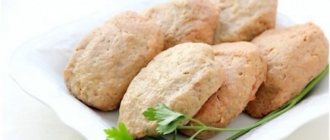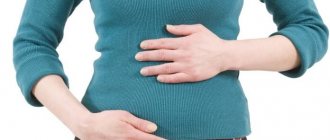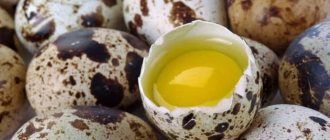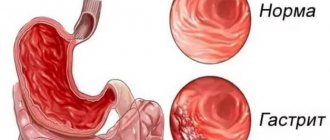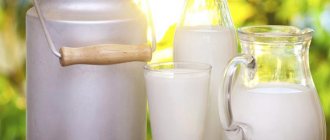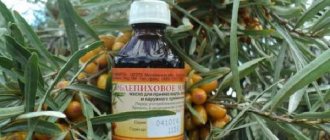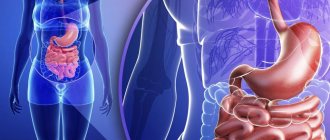Everyone understands that a diet for atrophic gastritis of the stomach imposes significant restrictions on the usual food intake, but is everything really that bad? No, and now we will prove it to you!
It is known that this disease is associated with a gradual thinning of the gastric mucosa. Atrophy or death of parietal cells that produce hydrochloric acid occurs. Atrophic gastritis is most often a chronic disease, that is, it lasts for a long time.
It is caused by a number of factors, among which experts especially highlight poor nutrition and bacterial infection.
Patients with chronic atrophic gastritis are forced to adhere to a diet for a long time. We have already found out about nutrition for superficial gastritis, now we will figure out which foods will be useful in treating our illness, and what we need to avoid.
Diet for atrophic gastritis
As a result of the death of mucosal cells, the process of hydrolysis of proteins contained in food is disrupted, the concentration of acid increases or decreases, which is normally 0.3-0.5%.
The surface cells involved in the synthesis of the substance that protects the walls of the stomach are also affected. The task of therapeutic nutrition for atrophic gastritis is to ensure that food does not overload the stomach.
Basic principles of the diet:
- total calorie content of the menu is up to 3000 kcal;
- mandatory volume of fluid consumed is 1.5 liters;
- the amount of salt is no more than 6 grams;
- fractional meals 5-6 times a day;
- the intervals between meals are no longer than 10 hours;
- the temperature of the dishes is between 20-60 degrees;
- with increased acidity, the consumption of “fast” carbohydrates is limited.
The high protein content in the menu (dairy products, meat, fish) ensures a sustainable process of mucosal regeneration.
Vegetable and animal fats reduce the secretion of gastric juice. Their role in the diet is played by sunflower or olive oil, as well as butter.
During exacerbation
In case of exacerbation of atrophic gastritis, the patient is recommended to completely fast for at least one day. After this, the patient is transferred to treatment table 1 according to Pevzner.
- For the first week, food is prepared pureed.
- Next, only cereals and vegetables are chopped.
- Tender fish or meat can be served in one piece.
- During an exacerbation, raw fruits, herbs, vegetables, and foods that are difficult or take a long time to digest are excluded from the menu.
The duration of fasting and adherence to one or another diet plan is determined by the doctor observing the patient’s condition.
The diet is gentle on the stomach , since the food is served crushed.
- Foods that stimulate juice secretion are excluded from the menu.
- During an exacerbation, first courses are prepared with vegetable broths and seasoned with ground cereals.
- The use of milk and noodles is allowed.
- Meat and fish are added chopped into ready-made dishes.
During remission
A common table involves the use of low-fat fish or meat broths when preparing soups.
The first courses are prepared without frying, seasoned with a milk-egg mixture during cooking. The finished dish can be seasoned with cream and butter. Meat should be chosen low-fat varieties .
Beef or veal, young lamb, rabbit, poultry (turkey and chicken) are suitable. You should choose a product without tendons and fascia. The skin is removed from the bird before cooking. You can supplement your diet with offal. The liver or tongue are suitable for this purpose.
Fish and seafood are necessary for the body as a supplier of protein and valuable microelements such as calcium, iodine, phosphorus. Hake, pollock, perch, and macrorus are suitable for the diet.
Bread and bakery products are a source of fast carbohydrates. They should be used very sparingly . They do not represent any special value; rather, it is a matter of habit. Fresh bread provokes fermentation processes, so you can only eat it stale or dried.
- Biscuits without additives, with a bland taste, and oven-dried biscuits are allowed.
- Occasionally you can indulge in unleavened pastries filled with apples, jam, meat, and cottage cheese.
- Flour products also include pasta, which is allowed for gastritis, but without the addition of hot seasonings.
Cereals are a source of slowly digestible carbohydrates. They leave you feeling full for a long time , which is important when following a diet. In addition, buckwheat, rice, wheat or oats contain substances that help strengthen the body and speed up recovery.
The cereal should be crushed after cooking. You can cook porridge with milk or water. Grains are added to first courses or used as side dishes.
Vegetables are the main source of fiber, vitamins and microelements .
In case of exacerbation, they are consumed after heat treatment, but the common table allows you to eat salads from raw vegetables, seasoned with vegetable oil. The list of permitted products includes: potatoes, beets, young peas, broccoli or cauliflower, pumpkin, zucchini. Dairy products are an essential component of the diet of patients with atrophic gastritis. This milk is no more than 2.5%, cottage cheese. The consumption of cheeses should be limited. Mild varieties are used in grated form once a week.
Eggs, despite their benefits, are not recommended to be eaten often . One or two are enough in the form of steam omelettes or soft-boiled.
Snacks during remission of the disease include soaked herring, high-quality boiled sausage, liver pate (homemade), beef and poultry ham.
You can eat raw fruits or berries during remission , but they must be ripe, with juicy pulp, and sufficiently sweet to taste. Watermelons, peaches, apricots, pears, apples, bananas, strawberries, raspberries are allowed.
You shouldn't overuse desserts.
You can allow a small amount of meringue, honey, jam without seeds and seeds, marshmallows or marshmallows. Among the drinks, preference is given to jelly, compote, herbal teas, and fresh juice . Tea or coffee is prepared in a small concentration, softening the taste with milk. A decoction of rosehip is useful.
Principles of diet organization
For those with atrophic gastritis, the diet should be organized according to the following principles:
- Food must be as gentle as possible.
- Fried foods are prohibited: they must be boiled, baked, or steamed.
- Food should be pureed or finely chopped.
- The food must contain the optimal amount of proteins and vitamins.
- Salt and sugar can be added in small quantities; any spices, especially hot, hot, spicy ones, are excluded.
- It is important to eat in small portions, at least 5-6 times a day.
- Be sure to set the power schedule according to the clock.
- The daily menu may contain approximately 100 g of protein, 100 g of fat and 400 g of carbohydrates. The total calorie content of the daily diet is 2800-3000 kcal.
- The food temperature should be pleasant to eat - about 50°C.
Important information: What is hyperacid gastritis
How to properly prepare dietary meals?
The food is boiled, cooked in a double boiler, and then thoroughly chopped . For some products, such as fish, you can use the “poaching” technique, in which the piece is filled halfway with water. A common table, indicated for chronic conditions, allows you to diversify the menu with baked dishes without a crust.
You can prepare steamed cutlets, soufflés or meatballs from fish, meat, or poultry for the patient. The aspic is prepared using a decoction of vegetables. The fish is prepared by first removing the skin. Beef Stroganoff is made from meat that has been previously boiled.
Vegetables are served as puree . An exception is made for sweet varieties of tomatoes.
- Pumpkin and zucchini are boiled, but not pureed.
- Berries and fruits are eaten raw or in the form of jellies, jelly, compotes, or baked with honey.
- Steamed puddings are prepared with the addition of semolina.
- Cottage cheese is suitable for preparing main courses or desserts. These can be casseroles, lazy dumplings, steamed puddings.
The main specificity of this disease
In the initial stages, it occurs practically without pronounced symptoms. More precisely, signals come from the body, informing about destructive processes, but most people brush them aside, blithely believing that everything will work itself out. The key to the name of the disease is the word “atrophy”. The cells of the inner layer of the stomach are gradually destroyed, losing the ability to secrete fermentation substances and gastric juice, as well as absorb nutrients. Most often, this results in low stomach acidity. It would seem that there is nothing wrong: acidity can be corrected. The main danger comes from another reason. Let's look at this in more detail. The development of pathology can be divided into two stages:
- The Helicobacter pylory bacillus attacks the gland cells of the inner walls of the stomach (this statement is true for many types of gastritis).
- Complex autoimmune processes aggravate the pathology. As a result, the stomach dies, unable to cope with its direct functions, becoming the cause of cancer.
The diet for gastritis and atrophic gastritis is designed to provide the body with all nutrients without overloading it.
Prohibited Products
Vegetables with coarse fiber and a sharp bitter taste , such as radish, white or red cabbage, turnips, radishes, rutabaga. Onions or shallots are introduced into the diet after heat treatment; they are prohibited in their raw form.
Greens with a high acid content (sorrel, spinach), as well as onions, are not included in the diet for gastritis.
Legumes, such as peas or beans,
cause fermentation in the stomach, so you should avoid them too.
Mushrooms are considered heavy food, but their consumption is prohibited only during an exacerbation. During the remission stage, it is permissible to use the product in the preparation of broth for first courses. You will have to give up fatty fish and meat : pork, duck, goose. Canned foods are contraindicated for gastritis due to their high salt content and chemical additives. The same can be said about smoked products.
Borscht, okroshka, and cabbage soup should be excluded from the first courses. Do not use rich broths or synthetic seasonings in preparing soups.
Pearl barley, millet, barley and maize will be too tough for a sick stomach. They are not suitable for first courses or side dishes.
You should not eat foods that irritate the walls of the stomach. This includes:
- marinades,
- cooking fat,
- margarine,
- fresh bread and pastries,
- tomato sauce,
- ice cream, chocolate,
- spicy seasonings,
- mayonnaise.
The use of sour cream for atrophic gastritis is limited to a minimum.
With a long period of remission, it is recommended to switch to a “zigzag” diet. This scheme involves expanding the diet for a short period, with a return to a gentle menu.
Additional Tips
If your doctor recommends surgery, you should under no circumstances refuse it. In the presence of necrosis, this is the only treatment method. But initially you will have to determine why the acidity is reduced. If due to chronic diseases of the gallbladder, then first of all they will have to be treated.
In summary, the best diet for atrophic gastritis is according to Pevzner (table number 1). The main thing in it is to consume exclusively crushed food, reducing the mechanical load on the stomach. But at the same time, the acidity of gastric juice must be artificially increased. This is where fruit juices (not concentrated) and seafood (low-fat) help best. At the discretion of the doctor, synthetic enzymes may also be prescribed.
Menu for atrophic gastritis for every day
The patient's menu must contain a sufficient amount of amino acids, carbohydrates, fats, vitamins and microelements . The diet includes sources of protein in the form of fish, dairy products, meat, vegetables and fruits, and cereals.
Breakfast
Breakfast options:
- Rice porridge with milk, boiled egg, green tea.
- Viscous buckwheat porridge, a little butter, chicory drink with milk.
- Steam omelette of 2 eggs, tea with milk.
- Semolina porridge, pureed sweet cottage cheese, weak coffee with added milk.
- Lazy dumplings with sour cream, tea, biscuit.
- Semolina porridge cooked with milk and cocoa.
- steam omelette or egg porridge, cottage cheese with honey, coffee with milk.
Lunch
We remind you that proper nutrition for gastritis should be fractional, 5-8 times a day.
Lunch options:
- Puree stewed apples.
- Peeled and baked pears.
- Bananas whipped with cream.
- Uzvar of pears and biscuits.
- Fruit jelly, cracker.
- Baked apple and plum juice.
- Peach puree, rosehip infusion.
On our website: Cauliflower and beneficial properties for gastritis
Dinner
Lunch options:
- Soup with vegetables and rice, steamed chicken cutlets, boiled buckwheat, rosehip infusion.
- Oatmeal soup with meatballs, rice porridge, fish balls, apple jelly.
- Milk soup with noodles, zucchini and cauliflower puree, pear compote.
- Vegetable soup - broccoli puree with carrots and onions, with a little cream; steamed chicken cutlets with buckwheat porridge, apple jelly.
- Mashed potato soup with dill, boiled veal, pumpkin and carrot puree with butter, compote.
- Puree soup with zucchini and broccoli, steamed chicken quenelles, pear compote.
- Cauliflower and carrot puree soup with chicken meatballs, fish souffle with mashed potatoes, berry jelly.
Afternoon snack
Afternoon snack options:
- Biscuit and tea with rosehip.
- Peach juice, biscuits.
- Cheesecake with cottage cheese, jelly.
- Coffee with milk, cookies.
- Carrot juice, sweet cottage cheese.
- Bearberry flour jelly with milk, unleavened cookies.
- Baked pear puree, chamomile tea.
Dinner
Dinner options:
- Mashed potatoes, boiled fish with milk sauce, tea with milk.
- Stewed fish with carrots and onions, rice porridge, rosehip infusion.
- Boiled chicken with zucchini puree. Dried apple compote.
- Pumpkin puree, steamed meatballs, green tea.
- Semolina casserole with jelly.
- Curd - carrot casserole, endive drink with milk.
- Baked pike perch with sour cream sauce, cauliflower puree, tea with milk.
Before going to bed, you should drink a glass of warm milk with a small amount of honey. You can eat an extra piece of bread at lunch and dinner.
Dishes for gastritis with low acidity
Many patients with diseases of the digestive system encounter difficulties during dieting. Since therapeutic nutrition involves a number of restrictions. Dishes for gastritis with low acidity should be prepared with gentle heat treatment, a minimum amount of fat and spices.
Recommended dishes for hypoacid inflammation of the gastrointestinal tract:
- Savory baked goods with cottage cheese, boiled lean meat, fish, fruits, vegetables or berries.
- Dry biscuits with sweet jams, marmalade or preserves.
- Soups based on fish, vegetable or low-fat meat broth. You can eat dairy, first courses with pasta.
- Meat and poultry without skin and fat: chicken, turkey, rabbit, young lean lamb. Meat can be boiled, baked, cabbage rolls, homemade sausages or cutlets.
- Low-fat types of fish, boiled and baked. You can make quenelles, meatballs, and soufflés from fish.
- The basis of the diet should be cereal dishes. Buckwheat, oatmeal, rice and other porridges are allowed for consumption. You can use them to make pilaf, boil or stew with vegetables.
- As appetizers, salads from fresh vegetables seasoned with vegetable oil or low-fat sour cream are allowed. You can also eat seafood, low-fat cheese, and diet sausages.
- Sour cream, low-fat cottage cheese and dishes made from it (pudding, casseroles, lazy dumplings), kefir.
- Vegetable dishes should be cooked boiled or stewed. Non-acidic sauerkraut is allowed.
- For sweet dishes, you can eat berry and fruit jams, marmalade, honey, marshmallows, marshmallows, and sugar.
Dishes should be prepared from products that stimulate the secretion of gastric juice. It must be steamed, baked or boiled. Smoked or fried foods are contraindicated as they contain a large amount of fat, which increases the secretion of gastric juice. Food should be served warm; it is advisable to chop/puree the food. To facilitate the digestion process, it is not recommended to eat dense and liquid foods at the same time. You should eat at the same time, that is, according to a strict schedule.
[20], [21]
Sauerkraut
For hypoacid gastritis, sauerkraut can be included in the diet. Unlike fresh, which causes heartburn, abdominal pain, nausea and vomiting, pickled has a beneficial effect on the gastrointestinal tract and the digestive process.
Sauerkraut should be consumed during the period of remission of the disease. The dish improves intestinal motility and microflora, eliminates constipation and inflammation of the mucous membrane. The vegetable can be used as a preventative against gastritis and stomach ulcers.
With low acidity, cabbage promotes the production of gastric juice. Sauerkraut and its brine are contraindicated for hypertension, kidney disease and damage to the cardiovascular system, gastritis with high acidity.
Restrictions on types of gastritis
Gastritis is a common gastrointestinal disease . There are various variants of the disease. What should you pay attention to in the diet of such patients? It should be noted that the first treatment table is suitable for patients with any type of gastritis. As the patient recovers, the diet is adjusted depending on the diagnosis.
Expert opinion
Irina Vasilievna
Practicing gastroenterologist
The list of permitted and prohibited foods depends on the acidity level. If it is low, you should exclude foods that provoke fermentation, in particular whole milk.
Foods that stimulate acid production are allowed, such as lemons or kefir, and fresh juices.
Focal gastritis is distinguished by the presence of individual affected areas . Nutrition for a patient with this diagnosis involves the use of menus No. 1a and No. 2 of the dietary table. With this type of gastritis, longer consumption of pureed foods is expected. The patient is prescribed an additional alkaline drink in the form of mineral waters “Narzan” or “Essentuki” No. 4 or No. 17.
Diffuse gastritis indicates the absence of serious changes in the mucosa. This is a kind of transitional form, when the damage is superficial, but a deterioration in the condition of the organ is already observed. A second table that is not wiped is recommended for patients. Hard-boiled eggs are allowed.
Antral gastritis or antrum gastritis is characterized by damage to the lower part of the stomach. Foods that stimulate secretory activity are excluded from the diet of such patients. The majority of the diet consists of pureed dishes with a slimy consistency.
In the hyperplastic form of atrophic gastritis, polyps or cysts form on the mucosa . Already at the initial stage of the process, the patient is prescribed a general diet, with a limitation of foods that irritate the mucous membrane.
On our website: Treatment of gastritis with propolis: 8 best recipes
Principles of dietary nutrition for various forms of disease
In this article we will talk about what diet should be followed for various types of diseases so that it is most effective for atrophic gastritis, and in what situations it can be prescribed, and we will also analyze possible menu options and daily diets during treatment of the disease.
Diet for chronic atrophic gastritis
Chronic form of the disease, a long-term illness requiring long-term treatment. The provoking factor in the development of the disease is an improper diet, consumption of alcoholic beverages, frequent use of medications, all of which disrupts the natural production of hydrochloric acid and digestive enzymes.
With atrophy of the mucous membrane, any gastroenterologist will insist on following a diet. As a rule, bland food is recommended. Degenerative changes in the walls of the stomach most often reduce the production of hydrochloric acid, so the food consumed should promote its production and enhance the enzymatic function of the digestive system. It is necessary to control the intake of all essential vitamins and nutrients from food.
Diet for focal atrophic gastritis
Focal gastritis is characterized by the formation of zones of atrophy of the stomach walls. In other words, there are areas in the stomach that cease to perform a secretory function, since the glandular tissue is partially replaced by epithelium.
Most often, in the focal form of the disease, diet No. 1a is prescribed, after some time the patient switches to diet No. 2. In addition, drinking mineral water, such as Narzan, Essentuki-4 or Essentuki-17, is recommended 15-20 minutes before meals.
It is recommended to drink herbal teas based on plantain leaves, St. John's wort, and wormwood half an hour before meals.
It is prohibited to consume alcohol, as well as food and foodstuffs that can damage the already suffering gastric mucosa. If such measures are not taken, treatment may take a very long time or have no effect.
Diet with diffuse atrophic gastritis
The diagnosis of the diffuse form of the disease in most cases means that there are no serious dystrophic problems in the stomach yet. This is a kind of transitional form, when damage to the mucous membrane is still superficial, but local areas of degeneration of glandular tissue are already observed. Symptoms of a disorder of the secretory function of glandular cells at this stage are already obvious.
Recommended diet is table No. 2. It activates the function of the glands. Dishes must be prepared by boiling, stewing or baking, but should not be fried. Do not use foods that are too cold or have a rough texture (coarse grains).
Diet No. 2 can be very varied, using meat and fish products. Dairy products and flour products are allowed. Eggs are prepared as steamed omelettes or boiled.
Be sure to include enough vegetables and fruits in your diet.
Diet for atrophic gastritis with low acidity
Reduced acidity appears as a result of atrophic processes in the mucous tissues of the stomach. The extent of the damage may depend on how large the damaged area is. Glandular cells gradually lose their ability to produce acid, which helps food process and digest. In addition, the production of mucus and enzymes, which are responsible for the absorption of nutrients, are reduced.
Changing your diet is the most important step in the treatment of low acidity gastritis. The diet should include foods that stimulate the production of gastric juice. Among such products are lean meat, fish, freshly squeezed juices, fruit and vegetable dishes. Prohibited dishes that can cause fermentation processes in the digestive tract: fresh baked goods, whole milk, etc. Food should be varied, but overeating should be strictly excluded: patients with atrophic gastritis eat fractionally, that is, often in small portions. This allows you not to burden your stomach.
Diet for atrophic gastritis with high acidity
The development of atrophic gastritis with high acidity is directly related to nutrition, that is, this pathology appears against the background of malnutrition. This means that first of all the patient must make adjustments to his menu.
In fact, for any type of gastritis, spicy, fried and fatty foods are excluded. Don't forget about bad habits that should also be avoided: smoking and drinking alcohol.
Eat at least five meals throughout the day. If the process worsens, the diet is followed for at least 3 months.
Eliminate acid-forming foods from the diet: mushrooms, radishes, fatty meats, fried foods, citrus fruits, grapes, soda, coffee, brown bread, spices, onions, garlic, mustard. Food should not be allowed to remain in the stomach for a long time: for this reason, hot, cold and heavy foods are excluded.
It is recommended to use skim fresh milk. It is better to replace raw fruits with boiled or steamed ones, as well as mashed potatoes or compotes. Rice porridge, mango, and oatmeal are welcome. It is preferable to grind all products, for example, in a blender.
Diet for atrophic gastritis with normal acidity
Patients with normal gastric acidity eat according to the principle of the course of the disease: with exacerbations, the diet becomes stricter, and during periods of remission, it is weakened.
When the disease worsens, it is recommended to eat mainly the so-called “slimy” first courses, prepared with the addition of rice and barley. You can eat oatmeal with milk or water. Eating in small doses, but quite often.
If loose stools predominate, it is recommended to drink freshly squeezed juices from pomegranate, carnelian, blueberry, black currant, and pear.
For persistent constipation, the emphasis is on using juices from carrots, apricots, and beets with the addition of vegetable purees. It is also recommended to use fermented milk products (fresh).
You cannot eat sweets or treats. It is recommended to drink green tea between meals (but not during meals).
Diet for antral atrophic gastritis
Most often in such cases Table No. 1a is prescribed, especially with severe pain. This diet should be followed for 10-12 days. The goal is to reduce irritation and reflex excitability of the gastric mucosa. Food is allowed to be crushed into a puree. As a rule, most of the diet consists of ground cereals, creamy soups and dishes based on dairy products, cottage cheese, yoghurts, and puddings.
After diet No. 1a, the patient switches to diet No. 1, which helps restore the damaged mucous membrane. This is a relatively advanced nutritional option, the purpose of which is to normalize the secretion and mobility of the digestive system. High fiber foods are not recommended, so all vegetables and fruits are served only in processed form (boiled, baked, jelly, but not raw).
Diet for atrophic hyperplastic gastritis
Atrophic hypertrophic gastritis is accompanied by the appearance of formations on the surface of the gastric mucosa; these can be cystic or polypous lesions. The cause of the disease is considered to be factors such as alcohol consumption, unnatural synthetic products, and allergic reactions to products.
Nutritionists recommend dietary nutrition, with the exception of foods that irritate the inner walls of the stomach. These are all fatty foods, pickles, muffins and flour, sour and spicy foods, raw fruits and vegetables. It is also necessary to give up cigarettes and alcoholic beverages.
Fully or partially limited products
The diet for atrophic gastritis excludes the use of:
- Foods that are difficult to digest in the stomach: fatty rough meat and fish, baked goods, raw fruits and vegetables, black bread, smoked meats, mayonnaise, mushrooms, fish/poultry skin, cartilage, fried pies, legumes, margarine, pancakes, fresh milk.
- Products that contribute to intestinal bloating and increased gas formation: legumes, raw vegetables, okroshka, millet soup.
- Some types of cereals (corn, millet, barley, pearl barley).
- Products that irritate the mucous membrane: garlic, salty/smoked foods, fresh onions, hot seasonings, turnips, radishes, radish, canned snack foods, rutabaga.
- Hot sauces, vinegar, ketchup, pepper and spices.
- Undiluted fruit/vegetable juices, strong black tea, coffee, sour fruits, kvass, alcoholic beverages.
Table of prohibited products
| Proteins, g | Fats, g | Carbohydrates, g | Calories, kcal | |
Vegetables and greens | ||||
| vegetables legumes | 9,1 | 1,6 | 27,0 | 168 |
| swede | 1,2 | 0,1 | 7,7 | 37 |
| cabbage | 1,8 | 0,1 | 4,7 | 27 |
| sauerkraut | 1,8 | 0,1 | 4,4 | 19 |
| green onion | 1,3 | 0,0 | 4,6 | 19 |
| bulb onions | 1,4 | 0,0 | 10,4 | 41 |
| cucumbers | 0,8 | 0,1 | 2,8 | 15 |
| canned cucumbers | 2,8 | 0,0 | 1,3 | 16 |
| white radish | 1,4 | 0,0 | 4,1 | 21 |
| turnip | 1,5 | 0,1 | 6,2 | 30 |
| canned tomatoes | 1,1 | 0,1 | 3,5 | 20 |
| horseradish | 3,2 | 0,4 | 10,5 | 56 |
| spinach | 2,9 | 0,3 | 2,0 | 22 |
| sorrel | 1,5 | 0,3 | 2,9 | 19 |
Mushrooms | ||||
| mushrooms | 3,5 | 2,0 | 2,5 | 30 |
Cereals and porridges | ||||
| corn grits | 8,3 | 1,2 | 75,0 | 337 |
| pearl barley | 9,3 | 1,1 | 73,7 | 320 |
| millet cereal | 11,5 | 3,3 | 69,3 | 348 |
| barley grits | 10,4 | 1,3 | 66,3 | 324 |
Confectionery | ||||
| candies | 4,3 | 19,8 | 67,5 | 453 |
Ice cream | ||||
| ice cream | 3,7 | 6,9 | 22,1 | 189 |
Cakes | ||||
| cake | 4,4 | 23,4 | 45,2 | 407 |
Raw materials and seasonings | ||||
| mustard | 5,7 | 6,4 | 22,0 | 162 |
| ginger | 1,8 | 0,8 | 15,8 | 80 |
| ketchup | 1,8 | 1,0 | 22,2 | 93 |
| mayonnaise | 2,4 | 67,0 | 3,9 | 627 |
| ground black pepper | 10,4 | 3,3 | 38,7 | 251 |
| chilli | 2,0 | 0,2 | 9,5 | 40 |
Dairy | ||||
| kefir | 3,4 | 2,0 | 4,7 | 51 |
| sour cream | 2,8 | 20,0 | 3,2 | 206 |
| curdled milk | 2,9 | 2,5 | 4,1 | 53 |
Meat products | ||||
| pork | 16,0 | 21,6 | 0,0 | 259 |
| ham | 22,6 | 20,9 | 0,0 | 279 |
Sausages | ||||
| dry-cured sausage | 24,1 | 38,3 | 1,0 | 455 |
| sausages | 10,1 | 31,6 | 1,9 | 332 |
| sausages | 12,3 | 25,3 | 0,0 | 277 |
Bird | ||||
| smoked chicken | 27,5 | 8,2 | 0,0 | 184 |
| duck | 16,5 | 61,2 | 0,0 | 346 |
| smoked duck | 19,0 | 28,4 | 0,0 | 337 |
| goose | 16,1 | 33,3 | 0,0 | 364 |
Fish and seafood | ||||
| dried fish | 17,5 | 4,6 | 0,0 | 139 |
| smoked fish | 26,8 | 9,9 | 0,0 | 196 |
| canned fish | 17,5 | 2,0 | 0,0 | 88 |
Oils and fats | ||||
| animal fat | 0,0 | 99,7 | 0,0 | 897 |
| cooking fat | 0,0 | 99,7 | 0,0 | 897 |
Non-alcoholic drinks | ||||
| bread kvass | 0,2 | 0,0 | 5,2 | 27 |
| black tea | 20,0 | 5,1 | 6,9 | 152 |
| * data is per 100 g of product | ||||
Diet and its basics
Soups are best made as a puree using meat, fish or herbal broth. For breakfast, doctors recommend preparing yourself porridge - semolina, rice, oatmeal. It is allowed to eat meat dishes in small quantities - lean beef, milk sausages, meat without fat, chicken, rabbit. Everything except sausages must be passed through a meat grinder.
Proteins can be replenished by eating seafood - mussels, shrimp, octopus. Allowed drinks are tea, cocoa, fruit and vegetable juices. Juices should only be freshly prepared. No baking, only crackers and bran bread. All fruits and berries must undergo the necessary heat treatment.
Sweets include mousse, honey, jelly, marmalade.
All dishes are served only warm.
With atrophic gastritis with low acidity, nutritional regulation is one of the important stages in the treatment of the disease. Foods in the diet should stimulate acid production. These are lean meats, fruit and vegetable dishes. You should not eat foods that can cause fermentation processes in the stomach - whole milk, baked goods, especially fresh ones.
Nutrition for gastritis with high acidity also has its own characteristics. Fried, fatty foods are completely excluded from food. The patient also needs to give up cigarettes, alcohol and drinks containing alcohol.
Nutrition for acute gastritis
Inflammation of the gastric mucosa is usually accompanied by abdominal pain and nausea. The acute phase of the disease is the most striking manifestation of the disease, requiring immediate changes in the usual lifestyle.
During the first day, the patient often has decreased appetite due to pain. This is the correct reaction of the body: during this period you should abstain from food so as not to aggravate the inflammation. You can drink liquids, preferably slightly warm water and tea.
On the second or third day, the so-called 1A diet begins (table No. 1A). It is allowed to eat liquid food, milk and cereal soups with a viscous consistency, pureed lean meat and fish, soft-boiled eggs, a small amount of butter and olive oil, weak tea, decoctions, jelly, honey.
Fresh vegetables and fruits, meat broths, coffee, soda, fermented milk drinks, bakery and confectionery products, and cheese are prohibited. It is better to do without salt or add it in minimal quantities; you will have to completely forget about other spices: nothing spicy, pungent, or sour should enter the stomach.
What diet is used for stomach disease
Specialists prescribe a specially developed diet No. 2. It is aimed at replenishing the body with vital nutrients and normalizing the functioning of the gastrointestinal tract. If the antrum of the stomach (its lower part) has been affected, then diet No. 1 is prescribed. For the atrophic hyperplastic form of gastritis, a menu is necessary with a limitation of foods that contribute to irritation of the walls of the stomach.
There are several principles that should be followed when eating for atrophic gastritis of the stomach:
- all products must be boiled, steamed, stewed, baked;
- baked goods are not allowed to be consumed fresh, only “yesterday’s”;
- At first, porridge must be cooked in water or diluted milk;
- cook soups using diluted broths from lean meats;
- add foods rich in vitamin C to your diet to increase acidity;
- There is no ban on vegetables and fruits in any form.
You need to take food in a pureed form in small portions to relieve the stomach of excess load;
In addition, there is a list of prohibited and permitted products for consumption.
| Prohibited Products | Authorized Products |
| Butters and other fresh baked goods | Stale bread, biscuits, crackers, biscuits that are not completely dried |
| Canned food and pickles | Dietary varieties of meat and fish |
| Fatty meats (pork, lard) and fish | Boiled eggs and steamed omelet |
| Some cereals: millet, pearl barley, barley | Cereals: rice, buckwheat, semolina, rolled oats |
| Sour soups, fatty broths, okroshka | Low-fat cheese, butter, low-acid dairy products |
| Horseradish, mustard, spicy sauces | Vegetable oil |
| Peas, beans and other legumes | Potatoes, carrots, cauliflower, cucumbers, tomatoes |
| Fried eggs, hard-boiled eggs | Fresh juices |
| Carbonated drinks, strong coffee | Pastille, marshmallows, marmalade |
| Smoked products | Cocoa, weak tea, jelly and compote |
| Fresh herbs |
General recommendations
For this disease, nutritionists prescribe diet No. 2. The goal is to provide the patient’s body with all the microelements, vitamins, fats and carbohydrates in the required quantities.
There is also a list of products that are included in the so-called “doubtful” list. Products made from it can be consumed, but only carefully and in small quantities. And some, such as table salt, are best replaced, for example, with sea salt. In addition to salt, this list includes sugar. Milk and products made from it, alcohol, especially strong alcohol, and sparkling water, beloved by many. Read more about alcohol for gastritis...
Only those foods that increase the patient’s appetite and the production of stomach acid are allowed for consumption. It is recommended to stew or boil food.
Authorized Products
The diet for atrophic gastritis includes:
- Concentrated broths based on lean meat/fish/mushrooms and first courses based on them with the addition of finely chopped vegetables and permitted cereals.
- Lean red meat (beef, pork, lamb), rabbit meat and poultry (chicken, turkey) boiled, baked or stewed (bits, cutlets, zrazy, quenelles).
- Low-fat fish (hake, pink salmon, cod, pollock, pike) in pieces or in the form of cutlets, meatballs.
- Dried (yesterday's) wheat bread, dry cookies, uneaten flour products.
- Broth-based jellied dishes, sauces prepared with meat broths for main courses.
- Porridges cooked with water/meat broth.
- Dairy/fermented milk products (kefir, yogurt, curdled milk, sour cream, omelet with cheese, grated cheese, milk, cottage cheese and cream in dishes).
- Vegetable puree (zucchini, potato, beetroot, pumpkin, carrot, cauliflower), green peas, stewed vegetables with the addition of garden herbs and vegetable oils.
- Ripe pureed fruits, oranges, baked apples, tangerines, watermelon, peeled grapes.
- Desserts: marshmallows, marshmallows, jam, marmalade, preserves, honey.
- Diluted vegetable/fruit juices, tea with lemon, mineral water, coffee and cocoa.
Table of permitted products
| Proteins, g | Fats, g | Carbohydrates, g | Calories, kcal | |
Vegetables and greens | ||||
| zucchini | 0,6 | 0,3 | 4,6 | 24 |
| cauliflower | 2,5 | 0,3 | 5,4 | 30 |
| potato | 2,0 | 0,4 | 18,1 | 80 |
| carrot | 1,3 | 0,1 | 6,9 | 32 |
| beet | 1,5 | 0,1 | 8,8 | 40 |
| pumpkin | 1,3 | 0,3 | 7,7 | 28 |
Cereals and porridges | ||||
| semolina | 10,3 | 1,0 | 73,3 | 328 |
| cereals | 11,9 | 7,2 | 69,3 | 366 |
| white rice | 6,7 | 0,7 | 78,9 | 344 |
Flour and pasta | ||||
| noodles | 12,0 | 3,7 | 60,1 | 322 |
Bakery products | ||||
| white bread crackers | 11,2 | 1,4 | 72,2 | 331 |
Confectionery | ||||
| jam | 0,3 | 0,2 | 63,0 | 263 |
| jelly | 2,7 | 0,0 | 17,9 | 79 |
| marshmallows | 0,8 | 0,0 | 78,5 | 304 |
| meringues | 2,6 | 20,8 | 60,5 | 440 |
| paste | 0,5 | 0,0 | 80,8 | 310 |
| Maria cookies | 8,7 | 8,8 | 70,9 | 400 |
Raw materials and seasonings | ||||
| honey | 0,8 | 0,0 | 81,5 | 329 |
| sugar | 0,0 | 0,0 | 99,7 | 398 |
| milk sauce | 2,0 | 7,1 | 5,2 | 84 |
Dairy | ||||
| milk | 3,2 | 3,6 | 4,8 | 64 |
| cream | 2,8 | 20,0 | 3,7 | 205 |
Cheeses and cottage cheese | ||||
| cottage cheese | 17,2 | 5,0 | 1,8 | 121 |
Meat products | ||||
| boiled beef | 25,8 | 16,8 | 0,0 | 254 |
| boiled veal | 30,7 | 0,9 | 0,0 | 131 |
| rabbit | 21,0 | 8,0 | 0,0 | 156 |
Bird | ||||
| boiled chicken | 25,2 | 7,4 | 0,0 | 170 |
| turkey | 19,2 | 0,7 | 0,0 | 84 |
Eggs | ||||
| chicken eggs | 12,7 | 10,9 | 0,7 | 157 |
Non-alcoholic drinks | ||||
| mineral water | 0,0 | 0,0 | 0,0 | — |
Juices and compotes | ||||
| apricot juice | 0,9 | 0,1 | 9,0 | 38 |
| jelly | 0,2 | 0,0 | 16,7 | 68 |
| carrot juice | 1,1 | 0,1 | 6,4 | 28 |
| pumpkin juice | 0,0 | 0,0 | 9,0 | 38 |
| rose hip juice | 0,1 | 0,0 | 17,6 | 70 |
| * data is per 100 g of product | ||||
